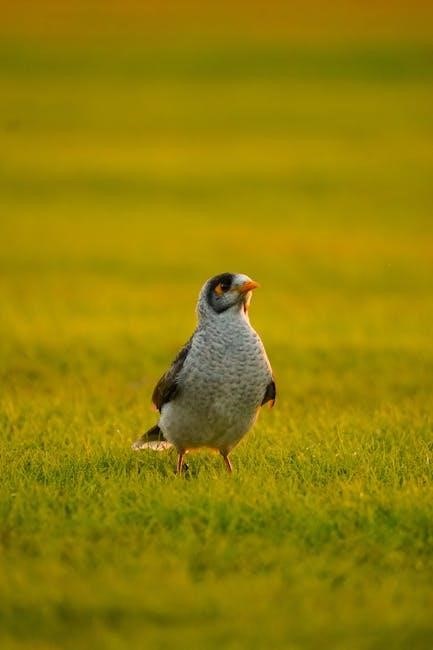
Australia’s diverse avifauna makes it a paradise for birdwatchers. A field guide is essential for identifying species, offering detailed descriptions, high-quality images, and distribution maps to enhance birding experiences.
1.1. What is a Field Guide?
A field guide is a comprehensive resource designed to assist in identifying and understanding species in their natural habitats. For Australian birdwatching, it typically includes detailed descriptions of bird species, high-quality illustrations, and accurate distribution maps. These guides also provide information on plumage variations, behaviors, calls, and habitats, making them indispensable for both amateur and experienced birders. A good field guide, such as the Pizzey and Knight guide, offers taxonomic details and updated classifications, ensuring users have the most reliable data for accurate identification. Its portability and user-friendly format make it an essential tool for enhancing birdwatching experiences across Australia’s diverse ecosystems.
1.2. Importance of Field Guides for Birdwatching
Field guides are indispensable tools for birdwatching, providing critical information for accurate species identification. They offer detailed descriptions, high-quality images, and distribution maps, enabling birders to recognize birds efficiently; These guides also include insights into behavior, plumage variations, and habitats, which are crucial for distinguishing similar species. For Australian birdwatching, a reliable field guide like the Pizzey and Knight guide ensures that enthusiasts have access to comprehensive and updated data. By enhancing observation skills and knowledge, field guides foster a deeper appreciation and understanding of Australia’s avifauna, making them essential companions for both novices and experts in the field.
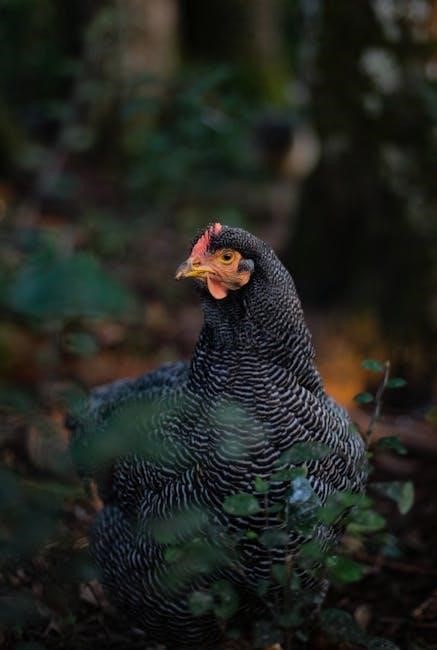
History of Australian Bird Field Guides
The evolution of Australian bird field guides reflects advancements in ornithology and identification techniques. Early works laid the foundation, while modern guides like Pizzey and Knight offer precise, detailed information, enhancing birdwatching experiences.
2.1. Early Developments in Bird Identification
The early development of bird identification in Australia relied heavily on detailed descriptions and illustrations. Field guides began to emerge, featuring paintings of species and maps to indicate their distribution. These resources were crucial for distinguishing between similar species and understanding their habitats. Over time, the inclusion of behavioral notes and plumage variations further enhanced accuracy. The foundational work laid in these early guides paved the way for modern, comprehensive field guides like Pizzey and Knight, which are now indispensable tools for both amateur and expert birdwatchers. These early efforts marked the beginning of a systematic approach to Australian ornithology;
2.2. Notable Contributions to Australian Ornithology
John Gould, a renowned ornithologist, made significant contributions to Australian bird studies through his detailed illustrations and classifications. His work laid the foundation for modern field guides. Later, Gregory Mathews and Harold Fletcher expanded this knowledge with comprehensive research and taxonomic classifications. These contributions were instrumental in establishing a clear understanding of Australia’s avifauna. More recently, authors like Pizzey and Knight have revolutionized field guides with their accessible and accurate descriptions. These notable contributions have collectively advanced Australian ornithology, providing essential resources for birdwatchers and scientists alike while promoting the conservation of unique bird species across the continent.
Key Features of a Comprehensive Field Guide
A comprehensive field guide includes detailed species descriptions, high-quality illustrations, distribution maps, and taxonomic information. It also features user-friendly formats and clear organization for easy identification and reference.
3.1. Detailed Species Descriptions
Detailed species descriptions in The Field Guide to the Birds of Australia provide in-depth information on physical characteristics, plumage variations, and distinguishing features. Each entry includes notes on behavior, habitat preferences, and vocalizations, aiding accurate identification. The guide covers over 800 species, offering insights into seasonal changes, sexual dimorphism, and juvenile plumage. Descriptions are concise yet comprehensive, ensuring birdwatchers can differentiate between similar species. The text is supported by high-quality visuals, making it a trusted resource for both novice and experienced birders. These descriptions are tailored to enhance field identification, ensuring users can quickly and confidently recognize birds in their natural environments.
3.2. High-Quality Illustrations and Photographs
The Field Guide to the Birds of Australia features exceptional illustrations and photographs, showcasing birds in lifelike poses and natural settings. These visuals highlight key identification features such as plumage patterns, beak shapes, and coloration. The images are meticulously detailed, capturing subtle variations between species, sexes, and age groups. Photographs are often paired with illustrations to depict birds in different lighting conditions or behaviors. This dual approach enhances recognition, especially for species with similar appearances. The guide’s visuals are organized alongside descriptions, making it easier for birders to compare and confirm identifications swiftly in the field.
3.3. Distribution Maps for Bird Species
Distribution maps in The Field Guide to the Birds of Australia are crucial for understanding the geographical range of each bird species. These maps detail where birds are commonly found, including specific habitats and regions. They distinguish between resident birds and migrants, providing insights into seasonal occurrences. The maps are meticulously color-coded and marked for clarity, helping birders pinpoint locations efficiently. Regular updates ensure the data reflects current population shifts and environmental changes, making the guide a reliable resource for both enthusiasts and researchers. This feature enhances the field guide’s practicality, allowing users to plan birdwatching excursions effectively.
3.4. Taxonomic Information
In The Field Guide to the Birds of Australia, taxonomic information is meticulously organized to reflect the most current scientific understanding of bird classification. Each species is categorized by family, genus, and species, with detailed notes on taxonomic relationships. The guide incorporates updates from genetic studies and ornithological research, ensuring accuracy. Scientific and common names are provided, along with subspecies designations where relevant. This section is invaluable for researchers and enthusiasts alike, offering a clear framework for understanding bird diversity. The taxonomic data is presented in an accessible format, making it a trusted reference for identifying and studying Australian bird species.
Bird Identification Techniques

This section explores essential methods for accurately identifying Australian birds, focusing on plumage, beak shape, size, behavior, and calls. The guide provides practical tips to enhance identification skills, ensuring birders can confidently distinguish species in the field. By combining visual and auditory cues, enthusiasts can refine their birding expertise. Detailed descriptions and illustrations further support effective identification, making this section a cornerstone for both novices and experienced birdwatchers.
4.1. How to Use Plumage for Identification
Plumage is a critical tool for identifying Australian birds, offering detailed insights into species characteristics. Birdwatchers should observe color patterns, distinctive markings, and feather textures, as these often differ significantly between species. Seasonal variations in plumage, such as breeding vs. non-breeding stages, can also aid in accurate identification. Field guides provide high-quality images and descriptions to highlight these features, enabling birders to recognize key differences. Paying attention to plumage details, such as wing bars, head patterns, and tail feathers, can help distinguish similar species. Understanding molt cycles and age-related plumage changes further enhances identification accuracy, making plumage a cornerstone of effective birding.
4.2. Understanding Bird Behavior for Accurate ID
Observing bird behavior is essential for accurate identification, as actions often reveal species-specific traits. Foraging habits, flight patterns, and social interactions provide critical clues. Birds like thornbills and honeyeaters exhibit unique foraging behaviors, such as probing flowers or foliage. Flight patterns, such as the swift darts of fairy wrens or the soaring of eagles, are distinctive. Social behaviors, like flocking or solitary habits, also aid in identification. Additionally, courtship displays and nesting behaviors can confirm species. By studying these behaviors, birdwatchers can complement plumage observations and improve identification accuracy, especially for birds that appear similar. This holistic approach enhances the effectiveness of field guide use in Australian birding adventures.
4.3. The Role of Bird Calls in Identification
Bird calls are a critical tool for identification, as they are often more distinctive than visual features. Many Australian birds have unique vocalizations that can help distinguish species, especially when visual observation is challenging. For example, the laughing kookaburra’s loud cackle is unmistakable, while the eastern whipbird’s whip-like call is iconic. Diurnal variations, such as the golden whistler’s melodic song during breeding season, further aid identification. However, mimicry by some species, like the lyrebird, can complicate identification. Birdwatchers often combine call recognition with visual cues and habitat knowledge to accurately identify species. Learning and recognizing these vocalizations enhances birding experiences and improves field guide effectiveness.
Habitat and Distribution of Australian Birds
Australia’s diverse ecosystems, including rainforests, deserts, and wetlands, support a wide range of bird species. Distribution varies greatly, with many birds adapted to specific habitats, ensuring survival and biodiversity across the continent.
5.1. Major Ecosystems in Australia
Australia’s diverse ecosystems play a crucial role in shaping bird habitats. Tropical rainforests in northern regions, such as the Daintree Rainforest, provide lush canopies for species like the cassowary. Coral reefs and coastal wetlands attract seabirds and shorebirds, while arid deserts, including the Outback, support hardy species adapted to extreme conditions. Temperate forests, grasslands, and woodlands offer habitats for parrots, honeyeaters, and robins. Wetlands and mangrove swamps are vital for waterfowl and migratory birds. Urban areas, though modified, still host native birds like kookaburras and lorikeets. This ecological diversity ensures a wide range of bird species thrive across the continent.
5.2. Bird Migration Patterns in Australia
Australia experiences significant bird migration patterns, with many species traveling long distances seasonally. Migratory birds like Latham’s Snipe and Eastern Curlew fly from breeding grounds in Japan, Siberia, and Alaska to Australia’s wetlands during the southern summer. These migrations often follow established flyways, such as the East Asian-Australasian Flyway. Some species, like the Crimson Chat, migrate within Australia, moving from arid regions to areas with abundant food and water. These movements are influenced by seasonal changes, food availability, and breeding cycles. Understanding these patterns aids birdwatchers in predicting species presence and enhances the likelihood of sightings during field excursions.
5.3. Urban vs. Wild Bird Habitats
Australia’s bird species inhabit diverse environments, ranging from urban areas to remote wilderness. Urban habitats, such as parks and gardens, attract birds like the Australian Magpie and Rainbow Lorikeet, which thrive in human-modified landscapes. In contrast, wild habitats, including forests, grasslands, and wetlands, support native species like the Superb Fairy-wren and Yellow Thornbill. Urban areas often provide abundant food but lack the complexity of natural ecosystems, leading to reduced biodiversity. Wild habitats, while more challenging to access, offer unique opportunities to observe birds in their natural settings. Understanding these differences is crucial for effective birdwatching and conservation efforts in both environments.
5.4. Case Studies of Unique Bird Habitats
Australia is home to several unique bird habitats that are essential for birdwatching. The Daintree Rainforest in Queensland, as the oldest continuously surviving rainforest, hosts numerous endemic bird species like the Buff-breasted Paradise Kingfisher and the Victoria’s Riflebird. These birds are found nowhere else on Earth, making this habitat irreplaceable. Moreover, the mangrove ecosystems along the northern coasts serve as crucial breeding and feeding grounds for shorebirds such as the Eastern Curlew and the Whimbrel. These areas are vital for migratory birds, offering them refuge during their long journeys. Such unique habitats underscore the remarkable diversity of Australia’s birdlife and emphasize the importance of preserving these ecosystems for future generations to enjoy and study.
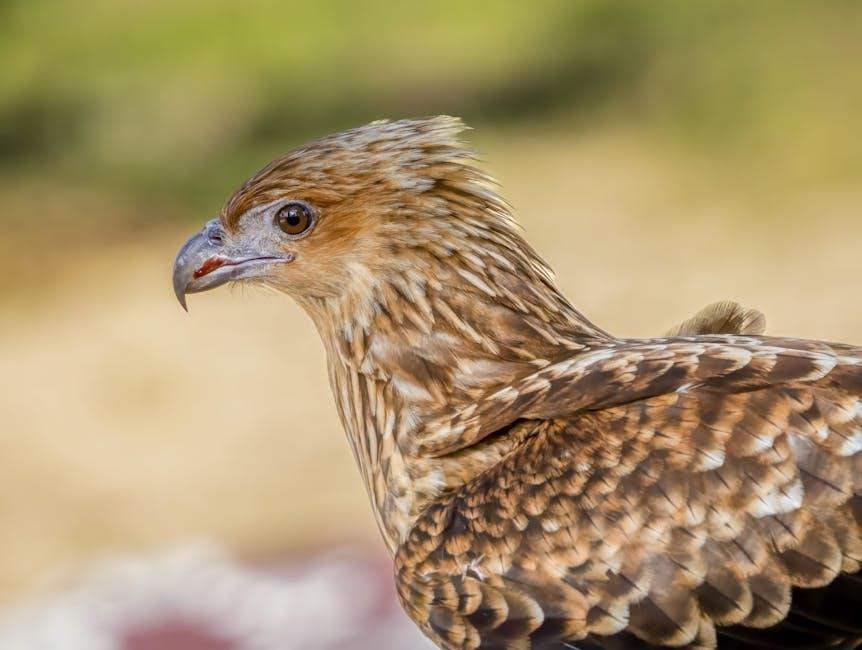
Behavioral Insights for Birdwatchers
Understanding bird behavior enhances birdwatching. Observing activity patterns, foraging habits, and social interactions reveals insights into species-specific traits, aiding accurate identification and enriching the birding experience.
6.1. Daily Activity Patterns of Birds
Understanding daily activity patterns is crucial for effective birdwatching. Most Australian birds are diurnal, active during daylight, while others, like nightjars and owls, are nocturnal. Crepuscular species, such as ibises and egrets, peak at twilight. Observing these rhythms helps birders plan sightings. For example, honeyeaters and lorikeets are most active in early mornings when foraging for nectar. Birds of prey, like eagles and kites, often hunt during mid-morning to late afternoon. Nocturnal species, such as tawny frogmouths, become active at dusk. Recognizing these patterns enhances the ability to locate and identify birds, making birdwatching more rewarding and efficient. Timing observations correctly can significantly improve success in the field.
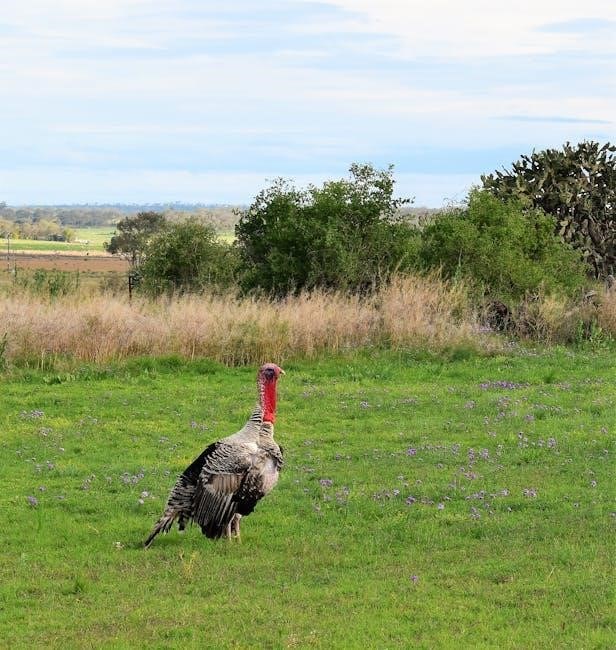
6.2. Breeding and Nesting Behaviors
Breeding and nesting behaviors vary significantly among Australian birds, influenced by climate, habitat, and species. Many birds, such as fairy wrens and robins, exhibit intricate courtship displays to attract mates. Nest construction is equally diverse, ranging from elaborate structures built by bowerbirds to simple scrapes in the ground by plovers. Some species, like cuckoos, practice brood parasitism, laying eggs in other birds’ nests. Understanding these behaviors aids birdwatchers in identifying species during breeding seasons. Observing nests can also provide insights into reproductive strategies and ecological roles, enriching the birdwatching experience and deepening appreciation for avian life cycles and adaptations in Australia’s unique environments.
6.3. Migration and Seasonal Movements
Australia’s birds exhibit diverse migration and seasonal movement patterns, shaped by food availability, climate, and breeding needs. Some species, like the Latham’s snipe, undertake long-distance migrations between Australia and Asia, while others, such as the budgerigar, make shorter, regional movements. Partial migrants, like the brown falcon, may shift altitudinally or latitudinally, while many tropical species remain resident year-round. Understanding these movements aids birdwatchers in predicting species presence and abundance. Seasonal changes in bird distributions highlight the dynamic nature of Australian ecosystems, offering unique opportunities to observe species in different habitats and contexts throughout the year.
6.4. Evolutionary Adaptations in Australian Birds
Australian birds have developed remarkable evolutionary adaptations to thrive in the continent’s diverse and often harsh environments. Many species, such as the emu and kookaburra, exhibit water-conserving traits, crucial in arid regions. Rainforest birds like the lyrebird have evolved vibrant plumage and mimicry skills to navigate dense ecosystems. Seabirds, such as albatrosses, possess wings adapted for long oceanic flights, while birds of prey have exceptional eyesight for hunting in open terrains. Bill shapes and sizes are specialized for specific diets, from seed-eating parrots with sturdy bills to nectar-feeding lorikeets with elongated beaks. Bright beak colors and patterns often serve mating or signaling purposes. These adaptations underscore the unique biodiversity and ecological balance of Australia’s avifauna, enabling species to occupy distinct niches and survive in varied habitats.
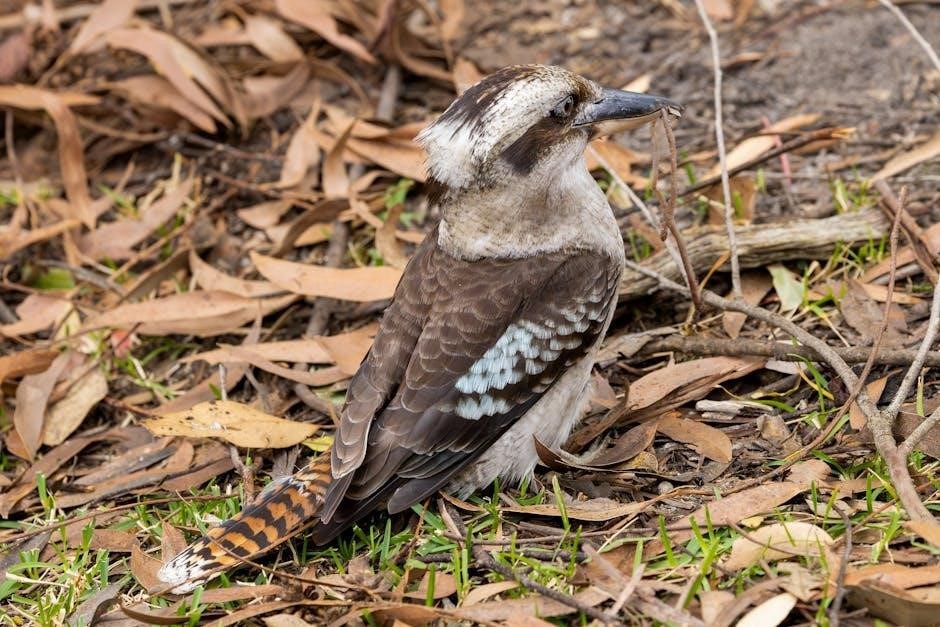
Conservation Status of Australian Birds
Australia’s bird population faces significant threats, with over 200 species listed as threatened or endangered due to habitat loss, climate change, and invasive predators.
7.1. Threatened and Endangered Species
Over 200 Australian bird species are classified as threatened or endangered, with habitat destruction, climate change, and invasive species being primary threats. The Orange-bellied Parrot, with fewer than 50 individuals remaining, is critically endangered. Other species, like the Gouldian Finch, face declines due to habitat loss and competition. Introduced predators, such as feral cats and foxes, exacerbate these challenges. Conservation efforts focus on protecting critical habitats and reducing predator impacts. Field guides play a crucial role in raising awareness about these species, enabling birdwatchers to contribute to their protection. Targeted actions are essential to prevent further declines and ensure survival of these unique birds.
7.2. Conservation Efforts in Australia
Australia has implemented numerous conservation initiatives to protect its avifauna. Programs like BirdLife Australia’s Threatened Species Project focus on habitat restoration and community engagement. National parks and wildlife sanctuaries provide safe havens for endangered birds. The Australian Government’s Environment Protection and Biodiversity Conservation Act plays a key role in legislating species protection. Additionally, invasive species control measures, such as feral cat eradication, are critical. Citizen science projects and birdwatching tourism also contribute by raising awareness and funding. These efforts highlight the importance of collaborative conservation strategies to safeguard Australia’s unique birdlife for future generations while addressing ongoing challenges effectively.
7.3. The Role of Birdwatching in Conservation
Birdwatching plays a vital role in conservation by promoting awareness and engagement. Citizen scientists contribute valuable data through bird counts and surveys, aiding researchers in tracking populations and habitats. Eco-tourism generated by birdwatching supports local economies, incentivizing communities to protect bird habitats. Field guides, like this one, empower enthusiasts to identify species accurately, fostering a deeper connection to nature. By educating the public about bird conservation, birdwatching inspires advocacy and action. This hobby not only enriches personal experiences but also directly supports efforts to safeguard Australia’s avifauna, making it a powerful tool for environmental stewardship and sustainability.
User Experience and Accessibility
This section focuses on enhancing the usability of field guides, ensuring accessibility for diverse audiences, including beginners and those with disabilities, through clear design and intuitive features.
8.1. How to Choose the Right Field Guide
Selecting the right field guide for birdwatching in Australia involves considering several factors. Look for guides with high-quality images or illustrations that accurately depict bird species. Ensure the guide covers a wide range of Australian birds, including rare and endemic species. Distribution maps are essential for understanding where birds can be found. Taxonomic accuracy is crucial, as bird classifications often change. Portability is another key factor; a lightweight guide is ideal for field use. Read user reviews to gauge a guide’s effectiveness, and consider digital versions for added convenience. Choose one that balances detail and accessibility to enhance your birdwatching experience.
8.2. Tips for Beginners in Birdwatching

For beginners, starting with binoculars and a reliable field guide is essential. Begin by observing birds in familiar environments, such as your backyard or local parks. Dress in neutral colors to blend in and avoid startling birds. Practice patience, as birdwatching requires time to spot species. Keep a journal to record observations, noting plumage, behaviors, and habitats. Learning bird calls can also enhance your ability to identify species. Start with common birds to build confidence before seeking rarer species. Respect birds’ habitats and follow ethical birding practices to ensure sustainable enjoyment. These tips will help you develop a rewarding birdwatching routine.
8.3. Using Technology for Enhanced Birding
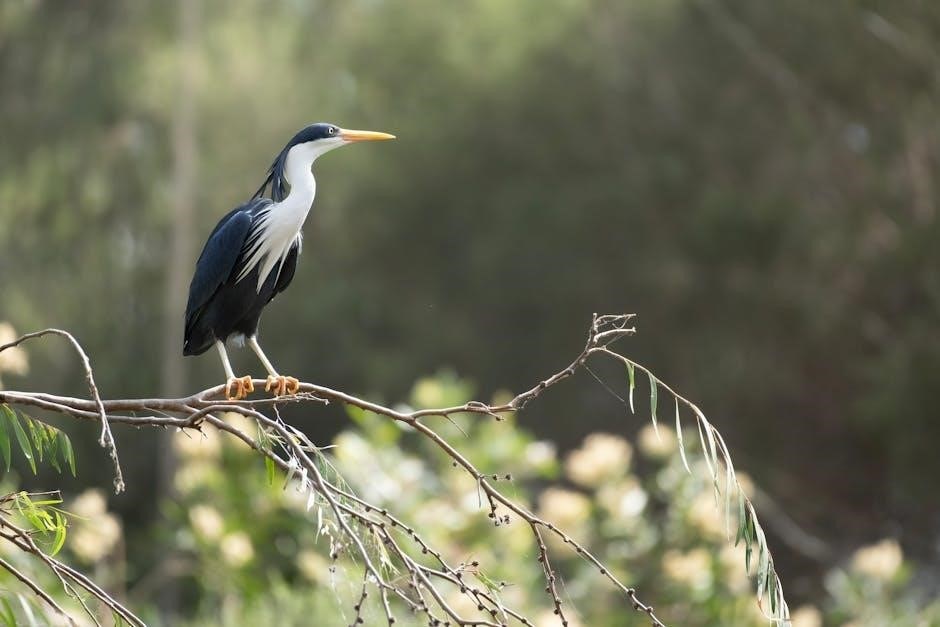
Technology has revolutionized birdwatching, offering tools to enhance the experience. Birding apps like eBird and iNaturalist provide real-time sightings and species identification. Digital field guides with searchable databases and high-quality images allow quick comparisons. Sound recording apps can capture and analyze bird calls, aiding in identification. GPS-enabled devices help locate birding hotspots and track sightings. Additionally, social media platforms connect birders globally, fostering knowledge sharing and community building. These tools complement traditional field guides, making birdwatching more accessible and efficient for enthusiasts of all levels. Embrace technology to deepen your understanding and enjoyment of Australian birdlife, ensuring a more informed and engaging experience.

Appendices and Additional Resources
The appendices provide essential resources, including a glossary of terms, a checklist of species, and recommended reading for further exploration of Australian birds.

9.1. Glossary of Birdwatching Terms
A glossary is an essential component of any field guide, providing clear definitions for birdwatching terminology. Terms like plumage, beak morphology, and habitat niche are explained concisely. It clarifies concepts such as migration patterns, endemic species, and avian taxonomy. This section helps bridge knowledge gaps for both novices and experienced birders, ensuring accurate identification and deeper understanding of Australian birdlife. By standardizing terminology, the glossary enhances the guide’s accessibility and usability for all readers.
9.2. Checklist of Australian Bird Species
The checklist is a detailed inventory of all bird species found in Australia. It includes scientific and common names, ensuring quick reference. Each entry is cross-referenced with corresponding page numbers for easy navigation; The list is taxonomically organized, reflecting current classifications. It also notes endemic species and migratory visitors, aiding in targeted birding. This tool is invaluable for tracking observations and planning expeditions, making it a cornerstone for both casual enthusiasts and dedicated researchers. The checklist enhances the guide’s practicality, fostering a systematic approach to birdwatching across Australia’s diverse regions.
9.3. Recommended Reading and Online Resources
For deeper exploration, this section provides a curated list of books, journals, and digital platforms. It includes seminal works on Australian ornithology, such as “The Birds of Australia” by John Gould, and modern field guides. Online resources like the Australian Bird Atlas and eBird Australia offer dynamic data on species distribution and sightings. Scientific journals such as Emu: Austral Ornithology are recommended for advanced readers. Websites like BirdLife Australia provide updates on conservation and research. Mobile apps, including iBird Australia, are highlighted for their utility in the field. These resources cater to both beginners and seasoned birdwatchers, fostering continuous learning and engagement.
This section concludes by emphasizing the enduring value of field guides in Australian birdwatching, their role in fostering deeper connections with nature, and inspiring future ornithological research.
10.1. The Importance of Field Guides in Modern Birdwatching
Field guides remain indispensable tools for modern birdwatching, offering concise and accessible information for enthusiasts. They bridge the gap between scientific knowledge and practical observation, enabling users to identify species accurately. High-quality field guides like The Field Guide to the Birds of Australia provide detailed descriptions, illustrations, and distribution maps, making them invaluable for both novices and experts. By fostering a deeper understanding of bird diversity, these guides inspire conservation efforts and promote a connection to nature. Their portability and comprehensive content ensure they remain essential companions, even in an era of digital resources, for anyone passionate about Australian ornithology.
10.2. Future Directions in Australian Bird Research
Future directions in Australian bird research emphasize advancing our understanding of species diversity, behavior, and conservation. Emerging technologies, such as AI-driven bird call recognition and satellite tracking, promise to enhance data collection and analysis. Climate change research will be critical, focusing on its impact on bird distributions and habitats. Collaborative efforts between scientists, Indigenous communities, and citizen scientists will foster inclusive and holistic approaches. Genetic studies will also shed light on evolutionary relationships and taxonomic classifications. By integrating cutting-edge tools and interdisciplinary collaboration, Australian bird research will continue to contribute to global ornithological knowledge and conservation strategies, ensuring the preservation of avifauna for future generations.

